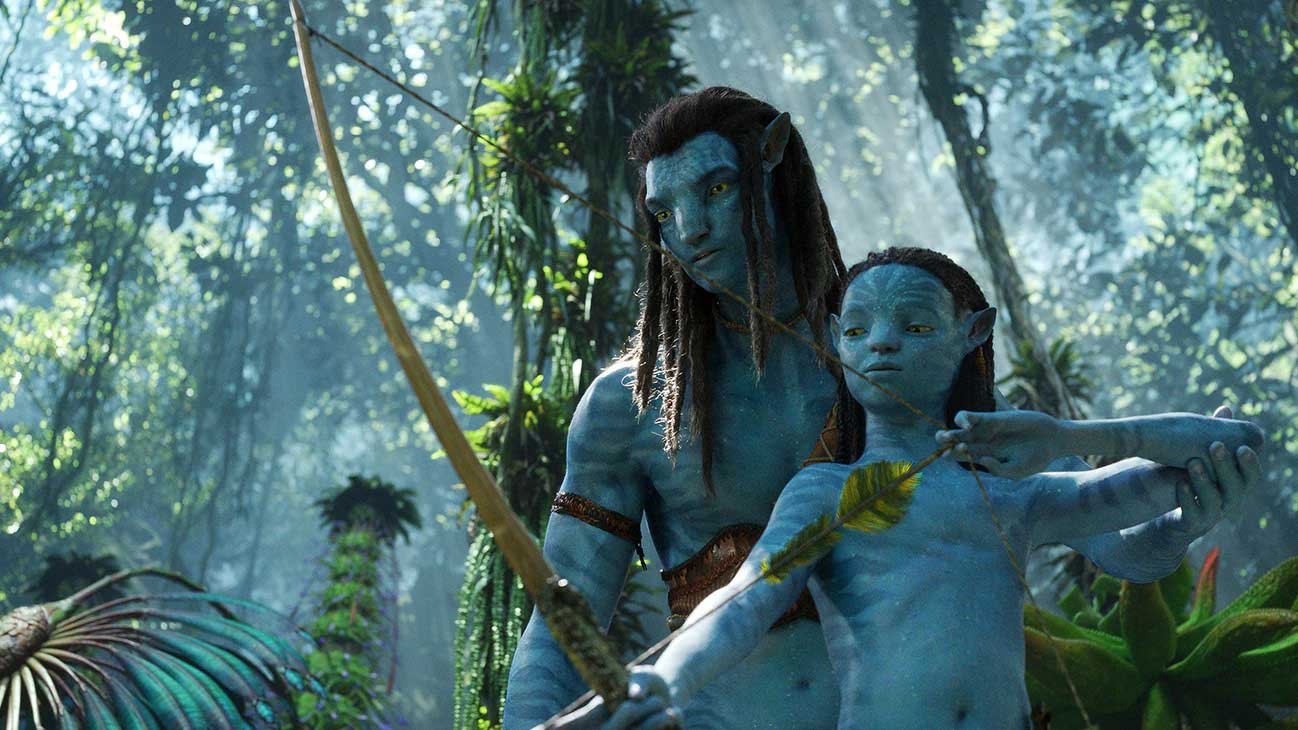The Environmental Message in ‘Avatar: The Way of Water’
16th December 2022
The first Avatar film (released in 2009 and directed by James Cameron) is a modern twist on the story of indigenous cultures being more in-tune with and closer to nature, and also more environmentally conscious, than their Colonial conquerors. The film is set on Pandora, an Earth-like habitable extrasolar moon in the Alpha Centauri System. In the film, people from Earth have begun to colonise distant planets and moons, such as Pandora, in order to exploit the rich resources that they are now lacking back on Earth. Pandora is a resource-rich planet with a diverse ecosystem, and prior to the arrival of settlers from Earth, the indigenous population, the Na’vi (‘The People’ in their own language), had lived in harmony with nature. But the resource hungry colonists are threating this balance and the Na’vi wage a war against them in defence of nature and Pandora’s natural resources, as well as to protect ‘Eywa’. Eywa is like a huge biological ‘internet’ where the trees and plants of Pandora have formed electrochemical connections between their roots that effectively act like neurons, and the trees act as computer servers that store information creating a moon-wide sentient ‘brain’ a little like a huge ‘Wood Wide Web’. The Na'vi believe that Eywa helps keep the ecosystem of Pandora in perfect equilibrium.
Avatar Synopsis
The first Avatar film is set 200 years in the future (around the year 2154) and most of the worst predictions of today’s environmentalists have come true - the resources on Planted Earth have almost all been used up, there is an energy crisis and as Elon Musk has suggested as a possible solution - humans have taken an imperialistic approach to colonising space in order to plunder the resources on other planets.
The film centres around the relationship between Jake Sully, a young paraplegic Marine veteran who becomes one of the ‘Avatar’ operators, where advanced technology allows him to remotely pilot a Na’vi body, that has been created in a lab. He is sent by the Resources Development Administration (RDA) a quasi-governmental organisation with its own militia and a mining subdivision, to gather intelligence for the RDA on how best to force the Na’vi to leave their resource-rich lands. Sully witnesses the RDA’s greed and brutality and changes sides to support the Na’vi in the defence of their lands. Through the project Sully is also offered the opportunity to temporarily leave his wounded body and through a new virtual body, to recover his mobility and his link to the land.
Promoting the Ecological Message of Avatar
From the outset, the creators of Avatar openly promoted the ecological message of the film, despite executives at Fox Studios having allegedly urged James Cameron to “tone down the tree hugger crap”. The DVD release of Avatar took place on April 22, 2010, the fortieth anniversary of ‘Earth Day’. Twentieth Century Fox Home Entertainment worked with the Earth Day Network to launch ‘The Home Tree Initiative’, where people who bought the Blu-Ray and DVD of the film were invited to participate in a reforestation project to plant one million trees around the world. Cameron urged people to “stand up and be warriors for the Earth by joining The Home Tree Initiative”.
“In creating this project, we wanted to make every tree count. That is why we selected ecosystems around the globe where we believed trees were most crucial to protect, and partners we were confident would work the hardest to get strong healthy trees in the ground and nurture them to maturity. While our requirements were high, in the end, the results of this project surpassed our expectations.”
‘Deep’ Ecology and Avatar
Deep ecology is a comparatively recent branch of ecological philosophy that considers humankind as an integral part of its environment and challenges the concept of the human need to dominate nature. Deep ecology distinguishes between shallow practices, such as recycling and composting, and the deep, more probing questioning a person needs to engage in to challenge the existing institutionalised worldview of the current society. Deep ecology rejects an anthropocentric view of nature where nature is viewed as something subordinate and inanimate, and where humans position themselves to gain the power to dominate the Earth. Rather it emphasises that humans should make a conscious return to nature, and develop an approach to nature promoting ecological harmony and equilibrium.
It has been noted that the ecological messages Avatar included both mainstream and ‘deep’ ecological themes and practices and that in this way the film’s messages are ‘deeper’ than just planting trees.
Avatar and ‘Ecotopia’
The film Avatar goes beyond raising awareness of environmental issues and deals with the concept of ‘Ecotopia’. This was defined by Lisa Garforth as a “self-conscious ecological utopianism” that emphasises “radically new ways of living with, rather than at the expense of, the natural world” (p.8) based on ecocentrism (nature-centered, as opposed to human-centered) with “the displacement of human consciousness from its privileged position at the centre of knowledge and value”.
“Radical ecotopias reject the logic of “more” and articulate a philosophy of “enough”, proposing that human well-being and fulfilment should be sought not in material progress but in spiritual, cultural and intellectual growth, in community and connections with others, and in an enhanced and vibrant relationship with the natural world. Embeddedness refers to the ecotopian argument that late modern society has become progressively separated and alienated from its natural support systems, both materially and conceptually. Ecocentrism sees proximity to nature – both in the sense of physical closeness to the earth and in terms of cultivating an ethics of empathy and interconnection with all living things – as crucial to an authentically green society and to human emancipation.”
A Vista on Pandora
Pandora is envisioned as such an ecotopia, inherently ecocentric as the Na’vi do not see themselves as the centre of knowledge or power, but as part of a network of flowing energy in which all beings, including the animals and trees, are equal, and where all of life is interconnected. As Silvia Martínez Flaquita notes, it is clear that there is nothing that the human colonists have or can offer, that the Na’vi want, as they live in perfect harmony with the environment, which provides for all their needs, and neither material possessions nor human learning is of any real value to them as their lives are based on ritual and spirituality and the opposite of expansion and consumption.
The Palulukan in the Room
To an extent though, the ‘Elephant in the Room’ with Avatar’* is the cliché of the Colonialist-who-falls-for-the-indigenous-princess-and-saves-her-tribe. Avatar has been accused of being ‘Dances with Wolves in Space’ and in the first film, Sully falls in love with Neytiri, a Na’vi Princess, who becomes his teacher in the ways of the Na’vi. When Neytiri’s father, Eytukan, is killed by falling wood during the destruction of the Hometree by the Colonial invaders, Sully becomes the Clan War Leader and leads a successful battle against the Colonial invaders and drives them from Pandora.
* A Thanator (called a Palulukan in Na’vi meaning “dry mouth bringer of fear”) is the largest animal native to the forests of Pandora.
As Silvia Martínez Flaquita describes “Put very simply … this is just another ‘going-Indian’ narrative: the white hero, discovering that the indigenous people he is supposed to be fighting are spiritually superior to his own corrupted race, rejects his origins and chooses to takes sides with the Natives, finally becoming their leader with the help - and love - of the indigenous princess”.
Avatar: The Way of Water
The sequel, Avatar: Way of Water, is set ten years after the first. Sully had been permanently transferred into his avatar after Neytiri saves his human body from suffocation at the end of the first film. The official film plot reads: "Jake Sully and Neytiri have formed a family and are doing everything to stay together. However, they must leave their home and explore the regions of Pandora. When an ancient threat resurfaces, Jake must fight a difficult war against the humans”.
In the ten years since the last film, Earth has become uninhabitable and the population of part now plan to colonise Pandora and make it their new home. They start by cutting down vast swaths of forest and then slaughtering Tulkuns (a race of highly intelligent whale-like beings) to harvest their brain enzymes for creating anti-aging remedies. As the name suggests, this sequel focuses on the oceans and waterways of Pandora, and the creatures that dwell within them.
Avatar – The Way of Water has a strong environmental message that has the potential to ‘inspire’ audiences according to producer Jon Landau, and actress Zoe Saldana, who plays Neytiri, said in a podcast hoped that this sequel would approach the topic in a way that wasn’t too ‘preachy’:
“Our planet is 80% water, so there’s so much more about our life on Earth that we don’t know because it lives beneath us and Pandora was sort of mirrored from that as well. Which means that when we saw Avatar 1 we only got to see 20% and that 20% took us for a ride that many of us across the globe have been unable to sort of shake. So imagine, what is the other 80%? Obviously we do know that with all of these relatable conversations that Jim (Cameron) is having around invasion, colonization, the erasure and genocide of civilizations, and the taking and the abuse of an environment. These are things we’ve seen throughout our history repeat themselves over and over again. So it’s not like we’re going to be seeing something that we’ve never heard of before, and I just hope it’s as thought provoking as the first movie was. Just to compel us in any shape or form to be more aware of each other, but also be more aware of our environment, but not in a way that’s preachy, just in a way that betters your life.”
Super/Natural
James Cameron’s other big current project is ‘Super/Natural’, a nature documentary series for National Geographic, and whilst a nature documentary series and a sci-fi blockbuster may not seem to have much in common, they both share an aim: to encourage and inspire people to care about nature again.
In an interview James Cameron said:
“In the Avatar films, we’re creating a fantasy world through which the viewer sort of perceives in 3D giant screen Imax a fantasy view of nature, but thematically underneath all that is this idea of the interconnectedness not only of nature with itself, but of us with nature, as inhabitants, as indigenous members of nature. So, it occurred to me that this series has a lot of the same thematic elements philosophically, right? We see these intricately interconnected animal and plant systems that have that have evolved over millions of years. And we get this jaw-dropping sense of wonder. You may look at a squirrel or an owl and say, well, that’s a familiar animal.
In Avatar, we’re designing these fantasy animals so if we told you they could see in ultraviolet and fly around the world and do all these things you wouldn’t just shrug, right? But when you see that a squirrel can not only fly, but identify his pals in moonlight by the ultraviolet-reflecting surface of the undersides of their bodies, all of a sudden you’re looking at our world, our amazing world, in a whole different light, literally and conceptually.
I think the goal of either of my major projects right now, Super/Natural or Avatar: The Way of Water, is to remind us how important nature is to us, and put us back into that kind of childlike perspective where we have this sense of wonder and connection to nature. Kids feel connected to nature. They’ll go out, they’ll come back filthy, they’ll come back having caught things and played with them and studied them. All kids are natural historians, natural scientists, and then they leave it behind and we move on and we live in an increasing state of nature deficit disorder.
So, a film like this re-creates that connection, that childlike sense of wonder, by showing us things we take for granted.”
It is fascinating to think that the highest-grossing film ever made so far (Avatar) is about nature-connection, activism and environmentalism, and that the only film likely to beat it is the sequel (Avatar 2: The Way of Water).
You can watch the Official Trailer for Avatar: The Way of Water below.
Post Avatar Depression Syndrome
The release of the second film in the series has prompted concerns that there will be a resurgence in ‘Post Avatar Depression Syndrome’ where people experience low mood after watching the film commonly attributed to a longing for the beautiful world of Pandora and the stark difference with reality back here on Earth, combined with feelings of hopelessness with the human race. You can read more in our article about ‘Post Avatar Depression Syndrome’.
If you have enjoyed this article and would like to support what we do by donating £2 or more to buy saplings, please follow the link below:























































